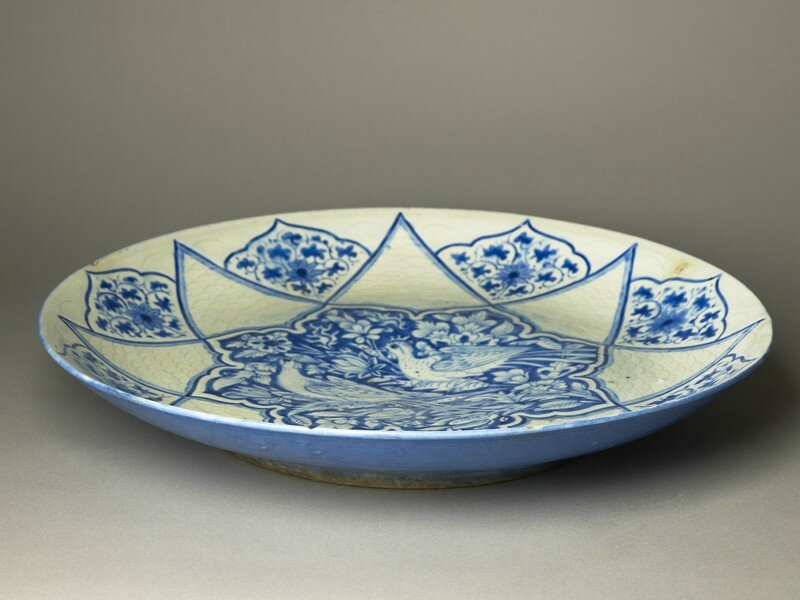Dish with pheasants amid foliage, Iran, Safavid Period (1501 - 1722)
Dish with pheasants amid foliage, Iran, Safavid Period (1501 - 1722), fritware, with incised decoration and underglaze painting in blue, 7.7 cm (height), 48 cm (diameter), at foot 27.5 cm (diameter). Gift of Gerald Reitlinger, 1978. (EA1978.2169). Ashmolean Museum © Ashmolean Museum, University of Oxford
Chinese ceramics and porcelain were eagerly collected by Islamic rulers in Egypt, Turkey and Iran from the early 15th century onwards. Through substantial purchases and rich diplomatic gifts, the collections of the Topkapi Palace in Istanbul and the Ardabil Shrine in Iran are not surprisingly amongst the most representative and comprehensive outside of China.
Blue-and-white Chinese porcelain, especially the refined wares of the Ming dynasty (1368-1644), have had a lasting impact on Islamic ceramic production. They not only influenced shapes and glazing techniques, but also enriched the decorative repertoire. Floral motifs like the lotus and the peony, fantastic creatures such as dragons and phoenixes, and fluttering cloud-bands became part of the Islamic artistic vocabulary at this time.
This impressively large plate shows how Eastern-inspired motifs could be used in combination with more indigenous patterns to produce highly inventive compositions. Here a vignette featuring two pheasants amidst peonies and lush vegetation acts as the centrepiece of a dynamic composition with three interlacing eight-pointed stars. Along with the balanced juxtaposition of coloured and plain areas, additional texture is provided by a moulded scale-like pattern that fills the white areas of the plate.

/https%3A%2F%2Fprofilepics.canalblog.com%2Fprofilepics%2F1%2F0%2F100183.jpg)
/https%3A%2F%2Fstorage.canalblog.com%2F03%2F02%2F119589%2F96711876_o.jpg)
/https%3A%2F%2Fstorage.canalblog.com%2F11%2F31%2F119589%2F94773502_o.jpg)
/https%3A%2F%2Fstorage.canalblog.com%2F20%2F83%2F119589%2F94772815_o.jpg)
/https%3A%2F%2Fstorage.canalblog.com%2F26%2F72%2F119589%2F75604929_o.jpg)
/https%3A%2F%2Fstorage.canalblog.com%2F59%2F60%2F119589%2F26458628_o.jpg)







/image%2F1371349%2F20240422%2Fob_2fdb25_438927724-1655365771900102-76795691742.jpg)
/image%2F1371349%2F20240422%2Fob_3a31e3_439671086-1655354688567877-66259303157.jpg)
/image%2F1371349%2F20240421%2Fob_0b06ea_438852036-1653622188741127-42693559183.jpg)
/image%2F1371349%2F20240410%2Fob_9e7fe3_435466567-1648812602555419-41946368105.jpg)